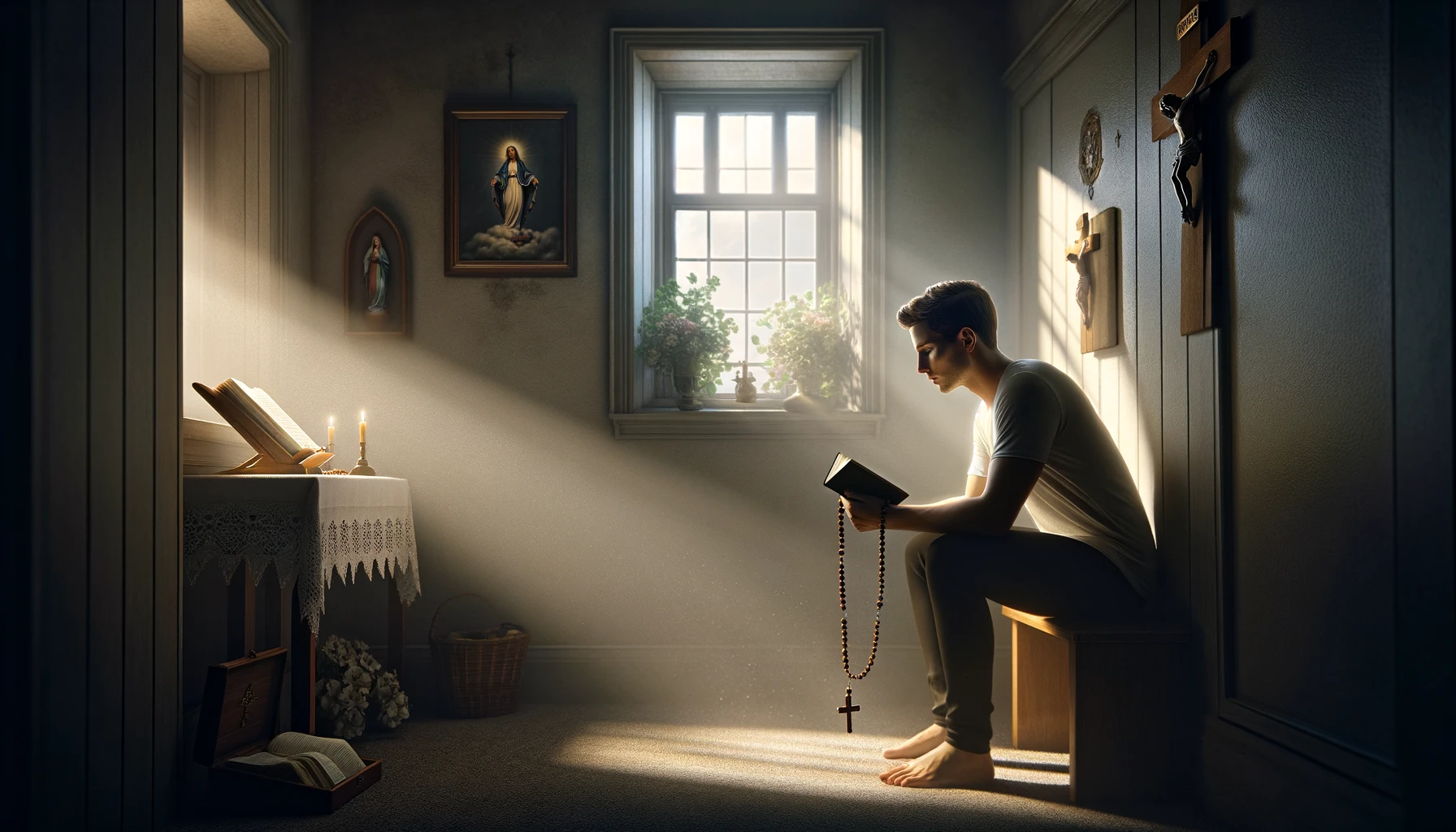Home>Special Themes>How Does Advent Prepare Us For Christmas


Special Themes
How Does Advent Prepare Us For Christmas
Published: February 12, 2024
Ericka Andersen, an editor at Christian.net, expertly merges digital strategy with content creation, focusing on faith and societal issues. Her communication skills enhance the platform's engaging narratives, fostering meaningful dialogue on belief's impact on society.
Discover how Advent, with its special themes and traditions, prepares our hearts and minds for the joyous celebration of Christmas. Explore the significance of Advent in deepening our spiritual connection and anticipation for the birth of Christ.
(Many of the links in this article redirect to a specific reviewed product. Your purchase of these products through affiliate links helps to generate commission for Christian.net, at no extra cost. Learn more)
Table of Contents
Introduction
Advent, a season of anticipation and preparation, holds a significant place in the hearts of Christians worldwide. As the days grow shorter and the air becomes crisper, the arrival of Advent signals the beginning of a spiritual journey leading up to the joyous celebration of Christmas. This period, typically spanning four weeks, serves as a time of reflection, hope, and expectation, setting the stage for the commemoration of the birth of Jesus Christ.
During Advent, individuals and communities engage in various traditions and rituals that not only mark the passage of time but also foster a sense of unity and spiritual growth. From the lighting of candles to the opening of Advent calendars, each practice carries its own symbolism and meaning, enriching the overall experience of the season.
As we delve into the history, traditions, and spiritual significance of Advent, we will uncover the profound impact this season has on the hearts and minds of those who observe it. Through this exploration, we will gain a deeper understanding of how Advent serves as a guiding light, illuminating the path toward the true essence of Christmas.
Read more: How To Prepare For Advent
The History of Advent
The history of Advent can be traced back to the early centuries of Christianity, with its origins rooted in the practices of the Western Church. The word "Advent" itself is derived from the Latin word "adventus," meaning "coming" or "arrival." This aptly encapsulates the essence of the season, as it symbolizes the anticipation of the coming of Jesus Christ.
The earliest records of Advent date back to the 4th and 5th centuries, when the Church established a period of fasting and preparation leading up to the celebration of the Nativity. Initially, Advent was observed as a time of spiritual readiness, akin to the Lenten season preceding Easter. It was a solemn period marked by prayer, reflection, and repentance, serving as a spiritual counterpart to the joyous festivities of Christmas.
Over time, the observance of Advent evolved to encompass a broader spectrum of themes and practices. The liturgical color associated with Advent, purple, symbolizes penitence and royalty, reflecting the dual nature of the season as a time of both solemn reflection and anticipation of the coming King. In some traditions, a third color, rose, is used to signify the third Sunday of Advent, known as Gaudete Sunday, a day of rejoicing amidst the preparatory period.
The structure of Advent as a four-week season, beginning on the Sunday closest to the feast of St. Andrew (November 30th) and culminating on Christmas Eve, gradually took shape. The four Sundays of Advent are marked by the lighting of candles on an Advent wreath, each representing a different aspect of the season: hope, peace, joy, and love.
As the centuries passed, Advent became firmly established as a time of spiritual reflection, joyful expectation, and hopeful anticipation. Its rich history and traditions continue to resonate with believers, serving as a poignant reminder of the profound significance of the Christmas season.
The historical roots of Advent provide a compelling backdrop for the contemporary observance of this sacred season, underscoring its enduring relevance and timeless appeal. Through an exploration of its origins, we gain a deeper appreciation for the spiritual depth and historical continuity that characterize the observance of Advent today.
The Advent Wreath and Candles
The Advent wreath, a cherished symbol of the season, serves as a focal point for many Advent traditions. Typically crafted from evergreen foliage, the circular shape of the wreath represents the eternity of God, with no beginning or end, while the evergreen branches symbolize hope and renewal. Adorned with candles, the wreath becomes a visual representation of the passage of time and the increasing anticipation of the coming of Christ.
The wreath is adorned with four candles, each with its own distinct significance. The first candle, often purple or blue, represents hope and is lit on the first Sunday of Advent. This candle, known as the "Prophet's Candle," symbolizes the anticipation of the coming Messiah, as foretold by the prophets of the Old Testament.
The second candle, also purple or blue, represents peace and is lit on the second Sunday of Advent. Referred to as the "Bethlehem Candle," it signifies the journey of Mary and Joseph to Bethlehem and the peace that Christ's birth brings to the world.
The third candle, pink or rose in color, is lit on Gaudete Sunday, the third Sunday of Advent. This "Shepherd's Candle" symbolizes joy and rejoicing, reflecting the joy that the shepherds experienced upon hearing the good news of Christ's birth.
The fourth candle, again purple or blue, represents love and is lit on the fourth Sunday of Advent. Known as the "Angel's Candle," it signifies the message of love brought by the angels and the love that Christ brings to the world.
In some traditions, a fifth candle, white in color, is placed in the center of the wreath and lit on Christmas Day. This "Christ Candle" represents the light of Christ coming into the world and serves as a focal point for the culmination of the Advent season.
As each candle is lit in succession, the increasing illumination serves as a visual representation of the growing anticipation and preparation for the celebration of Christ's birth. The ritual of lighting the candles, accompanied by prayers and readings, fosters a sense of spiritual contemplation and unity among those gathered around the Advent wreath.
The Advent wreath and candles, with their rich symbolism and profound significance, stand as a poignant reminder of the hope, peace, joy, and love that characterize the Advent season. As the flames flicker and the wreath becomes aglow with light, they serve as beacons of faith, guiding hearts toward the true meaning of Christmas.
Advent Calendars and Other Traditions
Advent calendars, a beloved tradition embraced by families and individuals around the world, serve as a delightful and meaningful way to count down the days leading up to Christmas. These calendars come in various forms, ranging from simple paper designs with perforated windows to intricately crafted wooden structures with miniature drawers. Each day of Advent, beginning on December 1st, is marked by the opening of a corresponding window or compartment, revealing a small treat, such as a piece of chocolate, a trinket, or a religious symbol.
The origins of the Advent calendar can be traced back to 19th-century Germany, where families would mark the days of Advent by drawing chalk lines on doors or lighting candles. The first printed Advent calendar is believed to have appeared in the early 20th century, featuring religious images behind each door. Over time, the concept evolved to include a wider array of themes, from traditional Nativity scenes to secular motifs, catering to diverse preferences and beliefs.
In addition to Advent calendars, a myriad of other traditions and customs enrich the observance of the season. Nativity scenes, or creches, are prominently displayed in homes and churches, depicting the birth of Jesus in Bethlehem. The gradual addition of figurines, including shepherds, wise men, and animals, culminates in the placement of the baby Jesus on Christmas Day, symbolizing the fulfillment of the long-awaited prophecy.
Caroling, the practice of singing festive hymns and carols, brings communities together in joyful celebration. Whether performed door-to-door or in communal gatherings, caroling fosters a sense of camaraderie and spreads the spirit of Christmas throughout neighborhoods and towns. Similarly, the custom of attending Advent services, marked by special liturgies and musical performances, offers a sacred space for worship and reflection during this season of spiritual preparation.
The observance of St. Nicholas Day on December 6th, commemorating the generosity and compassion of the beloved saint, is another cherished tradition. Children eagerly anticipate the arrival of St. Nicholas, who is said to leave small gifts and treats in their shoes, embodying the spirit of giving and kindness that characterizes the Christmas season.
These traditions, along with countless others, contribute to the rich tapestry of Advent observance, infusing the season with joy, reverence, and a sense of communal connection. As each custom unfolds, it weaves a narrative of anticipation and spiritual significance, guiding hearts toward the profound meaning of Christmas.
The Spiritual Significance of Advent
The spiritual significance of Advent extends far beyond the anticipation of Christmas; it encapsulates a profound journey of faith, hope, and renewal. At its core, Advent serves as a poignant reminder of the timeless promises embedded in the Christian narrative and the enduring message of salvation.
During Advent, the overarching theme of waiting permeates the spiritual landscape, mirroring the collective longing for the fulfillment of divine prophecies. This period of expectant waiting echoes the sentiments of the ancient Israelites, who yearned for the arrival of the long-awaited Messiah. It invites individuals to immerse themselves in the spiritual posture of anticipation, fostering a deep sense of connection to the historical anticipation of Christ's birth.
The four candles of the Advent wreath, each representing hope, peace, joy, and love, serve as beacons of spiritual contemplation, guiding hearts toward the essence of the season. As these candles are progressively lit, they illuminate the path of spiritual preparation, infusing the atmosphere with a sense of sacred anticipation and introspection.
Moreover, the spiritual significance of Advent is intricately woven into the fabric of Christian theology, emphasizing the dual nature of Christ's coming. It underscores the profound mystery of the Incarnation, wherein the divine intersects with the human, offering a message of hope and redemption to a world in need. This theological underpinning infuses the season with a sense of transcendence, inviting believers to reflect on the profound implications of Christ's birth for humanity.
The observance of Advent also serves as a call to spiritual renewal and preparation. It beckons individuals to engage in introspection, prayer, and acts of compassion, fostering a spirit of repentance and readiness for the coming of Christ. This period of spiritual introspection paves the way for a deeper appreciation of the transformative power of Christmas, as it invites believers to prepare their hearts to receive the gift of God's love incarnate in the person of Jesus Christ.
In essence, the spiritual significance of Advent transcends the boundaries of time and tradition, offering a timeless invitation to embark on a journey of faith, hope, and spiritual awakening. It stands as a testament to the enduring relevance of the Christmas narrative, inviting believers to embrace the profound message of love, grace, and redemption embodied in the birth of Christ.
Read more: How Do We Prepare For Advent
How Advent Helps Us Prepare for Christmas
Advent serves as a transformative and spiritually enriching period that plays a pivotal role in preparing hearts and minds for the celebration of Christmas. This season of anticipation and reflection offers a multifaceted approach to readiness, encompassing both the practical and the profound aspects of preparation.
First and foremost, Advent fosters a sense of intentional anticipation, inviting individuals to engage in a deliberate and purposeful journey toward Christmas. The ritual of counting down the weeks and days leading up to the Nativity serves as a tangible reminder of the approaching celebration, prompting individuals to prepare their homes, hearts, and communities for the joyous occasion. This intentional focus on the impending arrival of Christmas cultivates a spirit of readiness, prompting individuals to embrace the festive season with a sense of eager anticipation and joyful expectation.
Moreover, Advent provides a sacred space for spiritual introspection and renewal, offering a period of contemplation and preparation that transcends the hustle and bustle of the holiday season. Through the lighting of Advent candles, participation in special liturgies, and engagement with meaningful traditions, individuals are encouraged to carve out moments of quiet reflection, prayer, and meditation. This intentional pause amid the flurry of seasonal activities allows for a deeper connection to the spiritual significance of Christmas, fostering a sense of inner preparation that goes beyond the external trappings of the holiday.
In addition, the thematic progression of the Advent season, marked by the sequential lighting of candles symbolizing hope, peace, joy, and love, serves as a guiding framework for spiritual and emotional preparation. Each week, as a new candle is lit, individuals are invited to contemplate the profound themes encapsulated in the season, allowing these foundational elements to permeate their hearts and minds. This deliberate focus on the core tenets of hope, peace, joy, and love cultivates a sense of spiritual readiness, preparing individuals to embrace the true essence of Christmas with a renewed sense of purpose and meaning.
Furthermore, the observance of Advent traditions, such as the Advent wreath, calendars, and special services, fosters a sense of communal preparation, uniting families, friends, and congregations in the shared anticipation of Christmas. These collective rituals and practices create a sense of unity and shared purpose, fostering a communal readiness that extends beyond individual preparations. This communal aspect of Advent serves to reinforce the significance of preparing together as a community, strengthening the bonds of fellowship and shared faith as the Christmas celebration draws near.
In essence, Advent serves as a multifaceted and transformative journey of preparation, encompassing intentional anticipation, spiritual introspection, thematic contemplation, and communal readiness. Through its rich tapestry of traditions and rituals, this sacred season prepares hearts and minds to embrace the true meaning of Christmas, infusing the celebration with a depth of significance and joy that transcends the material trappings of the holiday.
Conclusion
In conclusion, Advent stands as a profound and transformative season that transcends the boundaries of time and tradition, offering a timeless invitation to embark on a journey of faith, hope, and spiritual awakening. From its rich historical roots to its enduring traditions and spiritual significance, Advent serves as a guiding light, illuminating the path toward the true essence of Christmas.
The history of Advent, rooted in the early centuries of Christianity, underscores the enduring relevance and timeless appeal of this sacred season. Its evolution from a period of solemn reflection to a multifaceted journey of anticipation and preparation reflects the enduring resonance of its core themes.
The Advent wreath and candles, with their rich symbolism and profound significance, serve as beacons of spiritual contemplation, guiding hearts toward the essence of the season. The ritual of lighting the candles, accompanied by prayers and readings, fosters a sense of spiritual unity and introspection, enriching the observance of Advent.
Advent calendars and other traditions, from Nativity scenes to caroling, infuse the season with joy, reverence, and a sense of communal connection. These cherished customs contribute to the rich tapestry of Advent observance, weaving a narrative of anticipation and spiritual significance that resonates with believers worldwide.
The spiritual significance of Advent extends far beyond the anticipation of Christmas; it encapsulates a profound journey of faith, hope, and renewal. This period of expectant waiting echoes the sentiments of the ancient Israelites, fostering a deep sense of connection to the historical anticipation of Christ's birth.
Ultimately, Advent serves as a multifaceted and transformative journey of preparation, encompassing intentional anticipation, spiritual introspection, thematic contemplation, and communal readiness. Through its rich tapestry of traditions and rituals, this sacred season prepares hearts and minds to embrace the true meaning of Christmas, infusing the celebration with a depth of significance and joy that transcends the material trappings of the holiday.
As we immerse ourselves in the timeless traditions and spiritual depth of Advent, we are reminded of the enduring message of hope, peace, joy, and love that lies at the heart of the Christmas narrative. This season of preparation not only enriches the celebration of Christmas but also serves as a poignant reminder of the profound spiritual truths that continue to resonate with believers across generations.














